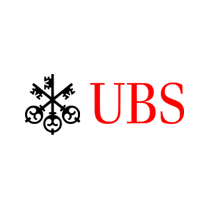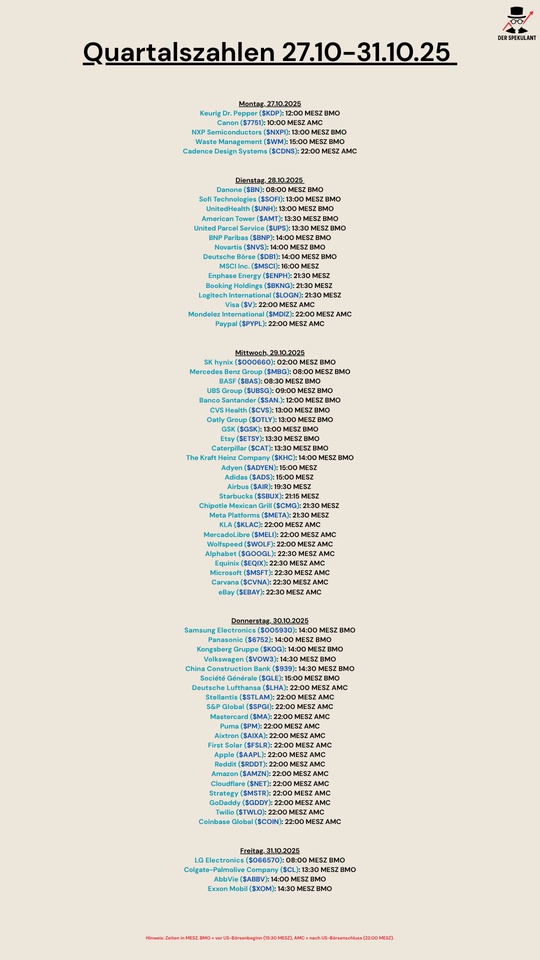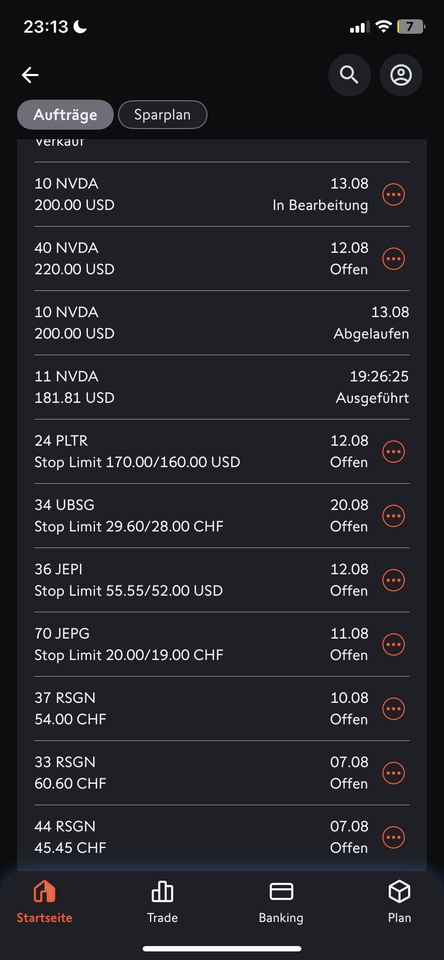Copper is currently continuing its strong rally. Further price increases are now also expected from $C (+0,38 %) expected. Citi expects a structural deficit resulting from strong demand from the USA & Europe, but also from limited supply expansion over the coming years. $UBSG (+2,93 %) & $JPM (+2,08 %) even expect 12-13k tons for the 2nd quarter of 2026. An increase in copper can have an inflationary effect due to the high import costs, while the direct economic benefit for the domestic industry is low. $965275 (-0,09 %) would be burdened in the medium term under these circumstances, as the US economy benefits more from the positive effects, while Europe suffers more from the negative effects.

UBS
Price
Discussion sur UBSG
Postes
58Quarterly figures 27.10-31.10.25
$KDP (-0,11 %)
$7751 (+0,92 %)
$NXPI (+0 %)
$WM (+1,03 %)
$CDNS (-0,44 %)
$BN (+0,69 %)
$SOFI (-0,08 %)
$UNH (+0,21 %)
$AMT (-0,14 %)
$UPS (+0,96 %)
$BNP (+0,83 %)
$NVS (+0 %)
$DB1 (-0,51 %)
$MSCI (+1,99 %)
$ENPH (+0,15 %)
$BKNG (+0,16 %)
$LOGN (-0,37 %)
$V (+0,32 %)
$MDLZ (+0,5 %)
$PYPL (-0,7 %)
$000660
$MBG (+0,11 %)
$BAS (+0,36 %)
$UBSG (+2,93 %)
$SAN (+0 %)
$CVS (+1,66 %)
$OTLY (+0 %)
$GSK (+0,14 %)
$ETSY (-0,41 %)
$CAT (+1,99 %)
$KHC (+0,04 %)
$ADYEN (+1,06 %)
$ADS (+2,31 %)
$AIR (+0,98 %)
$SBUX (+0,15 %)
$CMG (+0,8 %)
$META (-0,54 %)
$KLAC (-1,34 %)
$MELI (+0,67 %)
$WOLF (+0 %)
$GOOGL (-1,81 %)
$EQIX (-0,31 %)
$MSFT (+0,89 %)
$CVNA (-0,07 %)
$EBAY (-0,01 %)
$005930
$6752 (+5,5 %)
$KOG (-0,59 %)
$VOW3 (+0,49 %)
$GLE (+1,12 %)
$LHA (+4,96 %)
$STLAM (+0,2 %)
$SPGI (+0,19 %)
$MA (+0,18 %)
$PUM (+3,75 %)
$AIXA (-1,86 %)
$FSLR (-0,55 %)
$AAPL (-0,25 %)
$REDDIT (+0 %)
$AMZN (-0,64 %)
$NET (-0,52 %)
$MSTR (-0,62 %)
$GDDY (+0 %)
$TWLO (-0,77 %)
$COIN (-0,1 %)
$066570
$CL (-1,32 %)
$ABBV (-0,83 %)
$XOM (-0,21 %)



UBS to move to the us?
Colm Kelleher and Sergio Ermotti are secretly talking to members of the us administration. $UBSG (+2,93 %)
https://www.blick.ch/fr/suisse/clash-ubs-vs-suisse-discussions-avec-ladministration-trump-id21231419.html
Sale & repayment
Small sale of $NVDA (-0,81 %) .
129 shares and 200 stock options remain (2x long call contracts, 06.2026, 102 strike). So only 3% were sold.
Stop limit trades were also recorded.
The CC Funds ($JEPI
$JEGP) (-0,04 %) have become too hot for me under Trump and expected strong setbacks if he intervenes even more in the markets simply do not work with CC Funds. Was planned for sideways markets.
$PLTR (-0,89 %) is a "hot commodity".
$UBSG (+2,93 %) I have a large residual position and will adjust it a little if necessary. If necessary, I'll tighten the stop.
$RSGN I will set stop trades at 45 from a price of 50. I think that's still within a year's time.
Primary reason for the general liquidation thoughts: Tw. repayment of the Lombard loan.
Lombard loan key data:
Portfolio value: 247k
Lombard loan: 27.1k remaining amount, 30k max. Value to date.
Interest in CHF: 3.0%, p.a.
So around 11% of the current portfolio, or 12.3% of the loaned assets.
Primarily taken out in mid-April - May, around 15% return on average assets since then.
Even better: The loan was primarily used to make 2 trades (NVDA calls, 6k stake (170% return currently) & RSGN, 7k stake (24% return currently), which contribute strongly to the overall performance.
Calculated with the 15%, in 4 months, the Lombard (30k) brought me an additional 4.2k.
I don't have to pay it back - let it run a little longer if necessary...

UBS quarterly figures
The big bank $UBSG (+2,93 %) posted a profit of profit of 2.4 billion dollars which is twice as much as in the same period of the previous year. Adjusted for various special effects, this represents an increase of 2.68 billion (+30%). UBS has thus exceeded analysts' expectations.
Assets under management rose to USD 6618 billion (+7.8% compared to the first quarter).
With the integration of Credit Suisse, the bank is "still on track".
--> Bigger update as soon as I have time.
Source: FuW
Happy Investing
GG
UBS: The uncertainty discount is too large
The regulatory hurdles can be overcome. The market assessment should focus more on the operational execution of the integration. This offers opportunities for investors.
Article from FuW, supplemented by own commentary at the end.
The price targets for $UBSG (+2,93 %) drift far apart. The Analysten kommen auf keinen gemeinsamen Nennerhow the major Swiss bank can be reasonably valued. The pessimists see lows of close to CHF 20, while the optimists expect almost double that. This is mainly due to the differing expectations regarding the bank's future capital requirements.
Also im Aktienkurs spiegelt sich diese Unsicherheit. And this has been the case for April des letzten Jahres. The Federal Council then presented its regulatory plans to the public for the first time. A concrete figure followed in June of this year: 26 Mrd. $, so viel Kapital soll UBS aufbauen, to become crisis-proof. The proposal still has to go through parliament. There will be no final clarity until 2028.
Convincing implementation strength
The market is currently pricing in a high probability of a negative outcome on the regulatory front. This is indicated by the current valuation with a price-to-book ratio (P/B) of around 1.1. Compared to the closest comparable value, the valuation discount is more than 50%: The major US bank Morgan Stanley ($MS (-0,07 %) ) is trading at a P/B ratio of over 2.3. In Europe, the most profitable major banks such as Nordea ($NDA FI (-0,21 %) ), UniCredit ($UCG (+0,8 %) ) and Intesa Sanpaolo ($ISP (+0,59 %) ) are trading at 1.5, 1.4 and 1.3 respectively.
The uncertainty discount for UBS is too large. The integration of Credit Suisse is on track and value is being released on an ongoing basis. The progress already made is still not being sufficiently rewarded by the market. So far, management has been able to keep or exceed its promises. The strength of implementation is convincing. Cost synergies are being realized faster than planned, the Non-Core and Legacy unit is being efficiently wound down and the core businesses, such as Global Wealth Management, are flourishing.
For the courageous investor, the undervaluation is an opportunity. It opens up an attractive entry point, especially if you put the current share price in relation to the expected earnings per share for the future, before a Neubewertung nach Abschluss der Integration follows. This should be achieved by the end of 2026.
Titan is in the making
The UBS share now offers investors an asymmetrical risk/reward profile: the upside potential if the integration succeeds appears to be significantly greater than the downside risk. In terms of regulation, the worst-case scenario is known. Things can only get better for the big bank in the political process.
While waiting for clarification on the regulatory issue, the market should focus on the operational execution of the integration. UBS is forging a global champion - a titan is in the making. The bank's next quarterly reports will provide important clues on profitability and net new money. How it weiterhin Aktionärswert schaffen wants, UBS could communicate.
-------
Own opinion:
I hold $UBSG (+2,93 %) mainly because of the solid dividend policy, which is targeted in the medium term, and the general confidence in the Swiss financial center. There is enough time until 2028 not only to digest the regulatory requirements, but also to support them politically. In my opinion, the market is currently underestimating how much scope there is for strategic fine-tuning and targeted lobbying during this period.
As long as the integration continues as before in operational terms, I believe the potential for setbacks is limited - and investors' patience could pay off. In addition, I am in personal contact with a person who is involved in the integration and reports more success than failure. If the spin-off of the small loan business (consumer credit) is also successful, this will also free up short-term capital.
I hold - 674 shares at an average price of CHF 14.01.
------

UBS to start new share repurchase program
As part of the repurchase program approved at its Annual General Meeting on 10 April 2025, UBS Group AG announces the launch of a new two-year program to repurchase up to USD 2bn of shares.
Zurich, 30 June 2025 - As part of the repurchase program approved at its Annual General Meeting on 10 April 2025, UBS Group AG ($UBSG (+2,93 %) ) announces the launch of a new two-year program to repurchase up to USD 2bn of shares.
The new program is scheduled to start on 1 July 2025. As previously announced, UBS intends to repurchase up to USD 2bn of shares in the second half of 2025.
The program launched in April 2024 was closed after completing its aim of USD 2bn of share repurchases.
UBS will communicate its 2026 capital return ambitions with its fourth quarter and full-year 2025 financial results early next year.
--------------
And as a small service the explanation of share buybacks <3
A share buyback means that a company buys back its own shares on the market, thereby reducing the number of freely available shares. This spreads the profit over fewer shares, which automatically increases earnings per share. A higher EPS looks attractive to investors and can support or even drive the share price. Buybacks are often seen as a signal that the company believes in its own success and considers the share to be undervalued. Instead of investing the surplus capital in new projects, it is indirectly returned to the shareholders. In contrast to dividends, no money flows directly into the account, but the value per share increases. At the same time, the buyback reduces equity because money flows out of the treasury, which can improve the return on equity. Many companies also use buybacks to offset the dilution caused by employee share programs. This is usually a positive sign for investors because it shows confidence in the company's financial strength. A buyback often has a stabilizing effect, especially when the share price fluctuates. Nevertheless, a company must always consider whether it would be better to invest the money in growth, innovation or debt reduction. This is because a buyback is particularly worthwhile if there are no more attractive investment opportunities. What counts in the long term is that enough capital remains for new projects, crises or regulatory requirements. Used correctly, buybacks can therefore bring added value to shareholders without jeopardizing future viability. This is why investors often see them as a sign of maturity and solid management.
-------------
Happy Investing
GG

European Markets Steady Amid Fed Policy Decision and UK Inflation Decline
European stock markets remained steady on Wednesday as investors closely monitored the ongoing conflict between Israel and Iran while awaiting the conclusion of the latest Federal Reserve policy meeting. The DAX index in Germany dropped 0.1%, while France’s CAC 40 gained 0.2%, and the UK’s FTSE 100 rose 0.1%.
The geopolitical tensions between Israel and Iran have heightened market uncertainty, especially following reports that U.S. President Donald Trump convened senior advisers to review options, including strikes on Iran. Trump has demanded “unconditional surrender” from Tehran, warning that U.S. patience is “wearing thin”.
Meanwhile, investors are also cautious ahead of the Federal Reserve’s policy decision. The central bank is expected to keep interest rates unchanged, but market participants will closely analyze comments from Fed Chair Jerome Powell and his colleagues, particularly in light of cooling U.S. retail sales and growing recession risks.
In the UK, inflation cooled in May, with consumer prices rising by 3.4% annually, down from 3.5% in April. Services price inflation, a key metric for the Bank of England (BoE), also declined to 4.7% from 5.4%, aligning with the BoE’s forecast. The BoE is expected to keep rates on hold on Thursday, having previously lowered rates to 4.25% in early May.
In corporate news, $UBSG (+2,93 %) faced a downgrade from Morgan Stanley, which shifted its stance to “underweight” due to ongoing capital uncertainty and weaker earnings compared to peers.
Oil prices also saw a slight decline, reversing some of the previous session’s gains as the Israel-Iran conflict continued to weigh on market sentiment.
🇨🇭 Swiss Dividend & Defensive Growth Stocks – Ranked
I screened 7 global blue chips with a value/growth balance using my PASS and Buffett-style filters. Here’s the verdict:
🔝 1. Chocoladefabriken Lindt & Sprüngli ($LISP (-0,32 %) )
🟩 Score: 89 – Excellent
📈 WB Score: 7 (Grade B)
📌 Insider-led, durable moat, elite brand.
🚨 BUT: Price per share (CHF 12,210!) makes it impractical for my strategy.
🥈 2. Nestlé ($NESN (-0,22 %) )
🟨 Score: 75 – Strong
📈 WB Score: 4 (Grade D)
⚖️ Balanced income with global stability. Mildly overvalued but still attractive.
🥉 3. Mondelez ($MDLZ (+0,5 %) )
🟨 Score: 70 – Strong
📈 WB Score: 4 (Grade D)
🍫 Snack leader with consistent cash flows. Mildly overvalued, but solid anchor.
⚖️ Honorable Mentions
- Roche ($ROG (-1,13 %) ) – ⚖️ Fairly priced, insider-led, great pipeline, but slight value trap warning.
- Zurich Insurance ($ZURN (+0,64 %) ) – Stable, shareholder-friendly.
- UBS ($UBSG (+2,93 %) ) – Riskier financial play, some trap signals.
- On Holding ($ONON (-0,47 %)) – Growth potential, but overvalued; needs close monitoring.
🧠 Strategy Notes
✅ Favoring undervalued or stable-yield stocks with clear rotation plans.
❌ LISP is a dream stock, but high entry price makes it unsuitable for my dividend + compounding approach.
But I’m convinced it would make a fine addition to a portfolio and I will keep an eye on it and have it as one of my white whales!
Titres populaires
Meilleurs créateurs cette semaine









